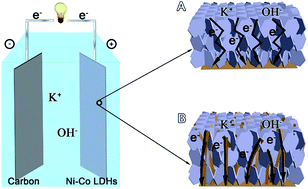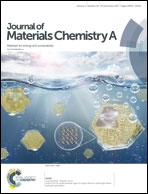A new architecture design of Ni–Co LDH-based pseudocapacitors†
Abstract
A facile and novel method of in situ growing a nickel–cobalt layered double hydroxide (Ni–Co LDH) nanosheet film on a three-dimensional Cu nanowire (NW) network on Cu foam is developed by three sequential electrochemical steps, which is free of any surfactant, stabilizer or organic binder. The hierarchically structured hybrid electrode is highly porous and endowed with greatly improved specific surface area, conductibility, and mechanical strength because of its unique structure with Cu NW networks crossed through Ni–Co LDH nanosheets. As pseudocapacitors, the as-prepared Ni–Co LDH hybrid electrode exhibits a significantly enhanced specific capacitance of 2170 F g−1 and an areal specific capacitance of 9.98 F cm−2 at 1 A g−1, which is comparable with or superior to most previously reported electrodes based on nickel–cobalt hydroxides. Moreover, the as-obtained electrode also exhibits an excellent rate capability with a specific capacitance of 1875 F g−1 even at a very high current density of 10 A g−1, which is about 86.4% of that at 1 A g−1. Besides, an excellent cycling performance is also obtained with a capacitance retention of 80.46% after 2000 cycles at a high current density of 6 A g−1, suggesting its promising application as an efficient electrode for electrochemical capacitors.



 Please wait while we load your content...
Please wait while we load your content...